I’ve got a small collection of Canon 35mm film SLRs. Here’s what I think of them.

The collection is a pretty good alpha to omega of FD and EF mount film SLRs, from the 1971 FTb to the 1994 EOS 1n with some ’80s fun thrown in the middle.
To save you the trouble of reading the whole thing, here are my conclusions up front:
- With a comparable lens and the same film these cameras produce pictures of *exactly* the same quality. The only difference between them is is how easy they make it to get the exposure you want. However complex the metering, however many autofocus points, all these cameras take photos focused on one point at one aperture and one shutter speed.
- If you’ve got FD lenses buy an FTb. They cost nothing and are a wonder of super-tough manual joy. There’s no need for multiple AF points (focus it on whatever you want), program AE and evaluative metering (choose your aperture and shutter speed with the help of the TTL meter). Brilliant.
- If you’ve got FD lenses and many quids to spare get a New F1 – probably my favourite camera here.
- If you’ve got EF lenses buy an EOS 600 (630 in the US). They cost nothing and are a wonder of ’80s automated joy.
- The ‘best’ camera here (most features, most options for putting you in control, the most advanced metering) is the EOS 1n. Personally, I prefer using the older cameras.
- Really, why are FTbs and 600s so cheap? They are brilliant. (I know why; it’s cos they never had the term ‘Pro’ associated with them.)
Canon FTb
Introduced: 1971

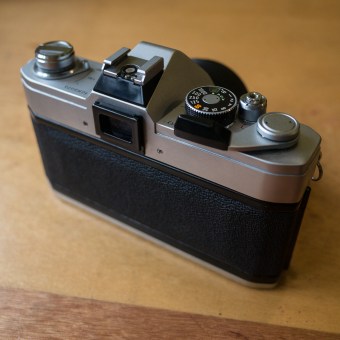

Summary:
Released alongside the F1, this was Canon’s first FD mount SLR. It is pretty basic, but with TTL metering it has everything you need and nothing you don’t. My dad gave me this camera circa 1975 – it was my first SLR so I’ve got a real soft spot for it.
It’s the essence of camera. No need for multiple AF focus points, no need for exposure compensation, no need for Av, Tv, AE or any other modes. Focus anywhere you fancy and set the aperture and speed with the help of the meter.

FT-b viewfinder
Pros:
Super-simple match needle metering. Just match aperture and the meter needles. This is a slightly later model that shows the shutter speed in the finder – useful Very, very robust. Feels like it is carved out of a solid lump of metal. All mechanical apart from the meter – you can take pictures without a battery These cameras are really, really cheap. They are a complete bargain. As cameras go, you can’t get better value for money than this. Cons:
- It isn’t point and shoot – you do need to focus, set the exposure and the shutter speed
- You can’t see explicitly what aperture you are at in the finder – but you can guess pretty much from where the aperture needle is.
- It’s a bit of a fiddle setting the shutter speed with the camera to your eye. You can do it with one finger, but it’s easier to hold the dial between thumb and forefinger. However you can only do that if you move the film advance lever out of the way.
- No shutter speed indication in the finder for early models – get a later one
Resources:
- Canon museum page: http://global.canon/en/c-museum/product/film79.html
- Manual: http://www.cameramanuals.org/canon_pdf/canon_ftb.pdf
Canon F1n
Introduced: 1976
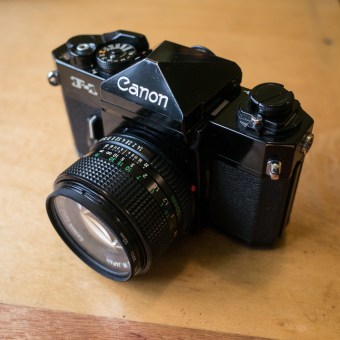


Summary:
The F1n is very, very similar to the FTb, the only major differences being the swappable finder and a higher max shutter speed. Oh, and it is black, which is nice.
The earlier F1, which is very much the same, was introduced in 1971 alongside the FTb. Camera geeks can tell the F1 and the F1n apart because the F1n has a film tab holder on the back cover.
Not to be confused with the New F1 (1981) which is a different beast inside. Camera geeks can tell the New F1 and the old ones apart because the new ones have a hot shoe on the finder and an ‘action grip’ on the side. The main advantage of the New F1 is its aperture priority AE finder, which unlike the old F1’s AE solution is normal size and doesn’t have an external battery pack.
(Really Canon, sort out your naming conventions.)
Like the FTb the match needle, TTL metering makes exposure modes and exposure compensation redundant. You’ve got complete control in the simplest possible way.

F1n viewfinder
Pros:
- Super-simple match needle metering. Just match aperture and the meter needles.
- Shutter speed is shown in the finder
- Unlike the FTb you can swap out the finder. As well as the standard prism there’s a waist-level finder, a bulky-complex servo finder (with massive external battery pack) for speed priority and an interesting-looking speed finder. You can also swap focusing screens fairly easily.
- It feels lovely, just as solid as the FTb
- Max shutter speed is 2000th (the FTb is 1000th)
Cons:
- Like the FTb there’s no automation (unless you stick on the massive Servo EE Finder with its external battery pack)
- Like the FTb you can work out the aperture from the position of the aperture needle, but there’s no explicit indicator
- Like the FTb the shutter dial is hard to turn with the camera up to your eye
- Decent F1s are expensive (overpriced, I’d say), hard to find and often broken
Resources:
- Canon museum page: http://global.canon/en/c-museum/product/film95.html
- Manual: http://www.cameramanuals.org/canon_pdf/canon_f1_winder.pdf
- Servo EE finder manual: http://www.cameramanuals.org/canon_pdf/canon_f-1_servo_ee.pdf
Canon A1
Introduced: 1978
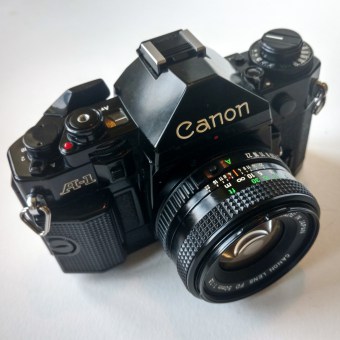



Summary:
Canon’s first SLR with a computer inside it delivering all the program modes – full auto, aperture priority, shutter priority and manual. Gone are needles and perspex discs in the viewfinder – this has got cutting-edge LEDs. Shame you have to press and hold a button to see them, but you do get both shutter speed and aperture.

A1 viewfinder
The camera feels dense and is a festival of buttons and dials. There are even two buttons (as well as the shutter button itself) to deal with exposure preview – one is a preview, the other a preview with exposure lock. You can’t help thinking there must be a less buttony way.
The main control is an interesting dial that sets either shutter speed (including a ‘P’ setting for full auto) or aperture depending on mode.
It’s the first, and very welcome, appearance of the control dial seen on lots of later Canons. The only difference is that it is small and tends to shred your finger. And if you want to see the results of your twiddling live in the finder you’ll have to hold down one of the preview buttons. (You can try half pressing the shutter button while moving the dial, but if you are anything like me you’ll end up firing the shutter as you try and find/turn the dial.)
All that aside, it’s a great camera that’s lovely to use. Not as fluid as later Canons – I find myself taking it away from my eye to change settings rather than holding buttons down – but it is solid, compact, and has everything you need.
Pros:
- All the program modes
- All the control you need
- Solid
- Can see both shutter speed and aperture in the viewfinder
- Can be had for reasonable prices
- Light and lovely to use
Cons:
- Buttons are a bit finger shredding and fiddly
- Have to hold a button to see info in viewfinder – the camera would be so much more usable at the eye if the info stayed on by itself, and holding the shutter button locked exposure
- Top speed is 1000th – limits use of wide apertures in bright daylight
- Manual mode shows you what your exposure should be, not what it is. Not very useful.
Resources:
- Canon museum page: http://global.canon/en/c-museum/product/film100.html
- Manual: http://www.butkus.org/chinon/canon/canon_a-1/canon_a-1.htm
- Another review by me
Canon New F1
Introduced: 1981




Summary:
When updating their F series Canon did a brave thing. Rather than beef up the ground breaking A1, they built a more up-to-date F1. They ignored the A1’s buttons and LEDs and kept the F1’s dials and needles. And they ignored the A1’s program AE.
What they added was a new AE finder option (you can change finders and focusing screens) that gives the F1 an aperture priority mode. Joy. (You can have shutter priority with a motor drive, but I don’t care about that.)
They also kept the original F1’s excellent match needle manual mode – the A1’s manual mode just doesn’t cut it.
And they gave the camera a new, matt finish. Somehow, despite the dials and needles, it feels modern.
Setting the speed dial to ‘A’ gives you a shutter speed scale with a needle to show what speed the camera has picked. You can see your aperture in the finder. Aperture is set by the aperture ring on the lens – better than having to use the A1’s fiddly wheel.
Move the speed dial off ‘A’ and you get an aperture scale, an aperture needle, a meter needle and you can see the shutter speed. Full manual joy.
It’s the best of both AE and manual worlds. If I had to keep just one of the cameras from this page (let’s hope I don’t start feeling the need for a Leica, or this could happen) it would be this one. (Actually, all these cameras together would cover about a third of a Leica M6 body.)

New F1 finder – aperture priority mode

New F1 finder – manual mode
Pros:
- Dials and needles – much more informative that just numbers, see your car’s speedo
- Aperture priority
- Excellent match needle manual mode
- Different scales for AE and manual – you always know what mode you are in
- Set the meter to ‘hold’ and it stays on for 15 seconds – you don’t have to hold a button
- Matt black!
- Solid and lovely to use
Cons:
- No AE lock – but you can easily switch to manual
- I find the shutter lock difficult – there’s something non-intuitive about it
- Slightly weird fiddly rewind button next to the film advance lever
- It’s heavy
Resources:
- Canon museum page: http://global.canon/en/c-museum/product/film105.html
- Manual: http://www.cameramanuals.org/canon_pdf/canon_f-1n.pdf
- See also: Canon New F1 – Needles, dials, aperture priority, joy
Canon T50
Introduced: 1983



Summary:
In the early ’80s Canon thought that some people just wanted a nice simple camera that took good pictures. Canon’s program modes were good, so why burden a camera with manual stuff? Hence the T50. It’s got no controls at all. Just a program mode, a self timer and a battery check. The viewfinder has a ‘P’ in it that flashes if there’s not enough light. You set the film speed manually, so you could use that to shift exposure, but that would be missing the point.
What we have here is a point, focus and shoot camera that takes canon lenses and has a WYSIWYG viewfinder. And I really like it. I like its honesty, its design, the materials… and I like using it. All you have to think about is aiming and focusing. You can’t fiddle about even if you want to.
Pros:
- All the quality, none of the complexity
- Good metering – it can seem a bit magical when it comes to backlit subjects
- Lovely design and materials – think Star Wars dark side aesthetic
- A better shutter than the A1 – metal not cloth curtain
- Motor driven film advance (though you rewind it yourself)
- Really, really cheap to buy
Cons:
- No control (but that’s not the point)
- No info in the viewfinder (and that’s not the point either)
Resources:
- Canon museum page: http://global.canon/en/c-museum/product/film109.html
- Manual: http://www.butkus.org/chinon/canon/canon_t50/canon_t50.htm
- Another review by me
Canon T70
Introduced: 1984

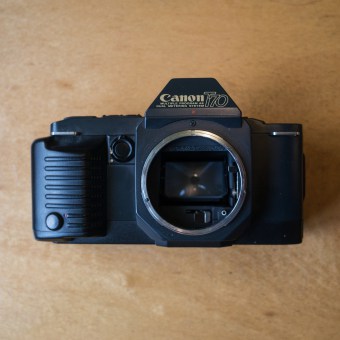

Summary:
An early move away from dials to buttons and LCDs. You get a couple of metering modes, program AE and a built-in motor drive. Much as I love this particular camera (my dad bought it new when it first came out – he loved a camera, and he loved a gadget; this ticked both boxes) it isn’t really much good.
As a manual focus point and shoot it is fine. The ability to shift the program towards either high shutter speed or widest aperture is nice. For anything else, the controls aren’t right. The T50 is a much more honest camera.
Pros:
- Really nice ’80s design, in lovely ’80s plastic (really, I like it, but perhaps it’s just me)
- There are three program modes – Program AE, Tele AE (fastest shutter speed) and Wide AE (smallest aperture). So you can get some point and shoot (with manual focus) action.
- Average and centre-weighted metering modes
- Has got safety shift (but I’d have to read the manual to see how it works)
- Very light, very compact
- Built in motor wind is nice. That said, I’m not interested in continuous shooting with film, so it’s no real advantage. I like the sound it makes though.
- Really, really cheap to buy
Cons:
- Generally difficult to use. While the LCD and buttons are steps in the right direction, they aren’t right. What you really miss is the control wheel by the shutter button. But that was yet to properly evolve after its early outing on the A1. The controls get in the way of your pictures.
- Can’t see shutter speed in the finder
- Can’t see finder info unless shutter or preview button is half pressed
- Can’t shift exposure in AE modes
Resources:
- Canon museum page: http://global.canon/en/c-museum/product/film112.html
- Manual: http://www.cameramanuals.org/canon_pdf/canon_t70.pdf
Canon T90
Introduced: 1986


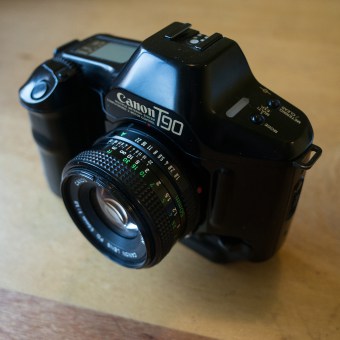
Summary:
This is more like it. The most sophisticated of the FD mount Canons. It’s got an LCD and buttons (like the T70) but now it’s got a control wheel by the shutter button, which makes all the difference. It’s a massive evolutionary leap forwards that’s still with us today.
If you’ve got FD lenses and you want automation and control this is the camera.
That said, much as I like this camera, you still have to focus manually. And if you have to be manual, go for a New F1 or an FTb – they put you in proper control. Automation always get in the way a bit. If you want automated, go the whole hog and get autofocus as well.
It’s got center weighted average, partial and spot metering. In spot metering mode you can take up to eight readings that are averaged.
The finder has an exposure scale on the right that shows current exposure and locked exposure. It also shows multiple spot metered values – a bit like on my 1Ds III.

The wonky LED panel is a special feature of this particular camera.
Usually with Canon a lower number means a more sophisticated camera. But not with the T series. (Really Canon, sort out your naming conventions.)
Pros:
- Lovely to hold and to use
- Control wheel – yeah!
- Useful program modes with safety shift
- You can shift the program modes
- Lots of useful info in the finder
- Nice multiple spot metering function (like I have on my 1DS III)
Cons:
- It is automated, but still manual focus
- You still have to hold a button down to see info in the viewfinder
- If you believe the interwebs it’s got a reputation for being tough. I’ve got two of these; one has a wonky display in the viewfinder, the other is plain dead. Like any other old camera, it isn’t invincible.
Resources:
- Canon museum page: http://global.canon/en/c-museum/product/film118.html
- Manual: http://www.cameramanuals.org/canon_pdf/canon_t90.pdf
EOS 600
Introduced: 1989


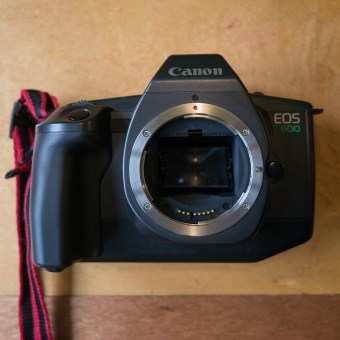
Summary:
The next big evolutionary leap, autofocus. With the EOS cameras Canon abandoned the manual focus FD mount and came up with the EF mount and a whole new series of autofocus lenses.
Called the EOS 630 in America, the 600 came hot on the heals of Canon’s first EF mount EOS camera, the EOS 650 (1987). The 600 (or 630) is basically identical to the 650 but with faster AF and faster film advance. (Really Canon, sort out your naming conventions.)
As a fully automated film SLR, I really like this camera. Stick it in the basic program mode, shift the exposure using the control wheel if you like, shoot. It is really nice to use.
Pros:
- Lovely ’80s look with lovely ’80s plastic and soft grip
- Compact, light, uncluttered
- 6-zone evaluative metering with 6.5% partial option
- Autofocus! (1 whole focus point)
- Fully automated, but you can shift the settings using the control wheel
- Control wheel!
- Useful info in the finder
- Finder info stays there for a while without you having to keep a button pressed. At last.
- You can get them for nearly nothing. Really, if you have some EF lenses, get one of these to play with. Like the FTb, it’s an absolute steal.
Cons:
- There are some program mode variations, and you can use it in manual, but it’s a bit of a faff. Best used in plain program mode.
- It’s got features I don’t use (like the presets for drive and autofocus modes that only work in full auto and need a crib sheet to remember)(but who cares, they don’t get in the way)
- I always have to search for the on/off dial. It’s in the wrong place.
- If you are used to modern autofocus cameras, the autofocus on this will feel slow and a bit hit and miss. Especially in portrait orientation. You’ll find yourself looking for contrasty edges for it to lock onto.
Resources:
- Canon museum page: http://global.canon/en/c-museum/product/film131.html
- Manual: http://www.cameramanuals.org/canon_pdf/canon_eos_630_pt1.pdf
EOS 1n
Introduced: 1994



Summary:
Top of the line film SLR joy. Solid, fast, quiet, all the controls you need and lots you don’t.
Canon had got the button layout right at this point. If you compare the top panel to this and the 1-series digitals you’ll see not a lot has changed.
Its got all the metering modes; 16 zone evaluative, centre-weighted average, 9% partial and a couple of spot variations (3.5 and 2.3%). Gosh. It’s got everything except the multi spot meter feature of the T90 and 1-series digitals.
The feature I appreciate most on this camera, and that’s missing on the 600, is a custom option for back button focus. Set focus with one button and exposure with the shutter button. A super-easy way to separate focus and exposure from the composition. I use the same config a lot on my 1DS III.

EOS-1n viewfinder
There’s also a nice feature in the viewfinder, an exposure level display that shows the actual exposure value relative to the metered value.
At last fully manual photography is possible with the camera at your eye. It’s got the dial by the shutter button, and a second dial on the back, under your thumb as you hold the camera. You can control the shutter with one, and aperture with the other. And see in the finder your exposure compared with the metered exposure.
Pros:
- Solid and lovely to use.
- All the metering modes
- Familiar controls (to anyone with a 1-series digital)
- Two control dials
- Back button focus
- Lots of info in the viewfinder
- Fast, accurate autofocus (compared with the 600) with 5 focus points (though I only use one)
- Good value for money – much cheaper than a 1v (which is better only in that it gives you a zillion focus points and more frames per second)
Cons:
- It’s got features I don’t use (but who cares, they don’t get in the way)
- The shutter button on mine is a bit squeaky and spongy – spoils the experience a bit
Resources:
- Canon museum page: http://global.canon/en/c-museum/product/film173.html
- Manual: http://www.cameramanuals.org/canon_pdf/canon_eos-1n.pdf
What’s missing?
When I first wrote this article I was missing an A1 and a T50. Now, thanks to eBay alchemy (A1) and the excellent Frank Lehnen (T50), I have both. So, what next? Perhaps an EOS 3 for the eye focus… and I could feed my love of ’80s plastic with a T80…